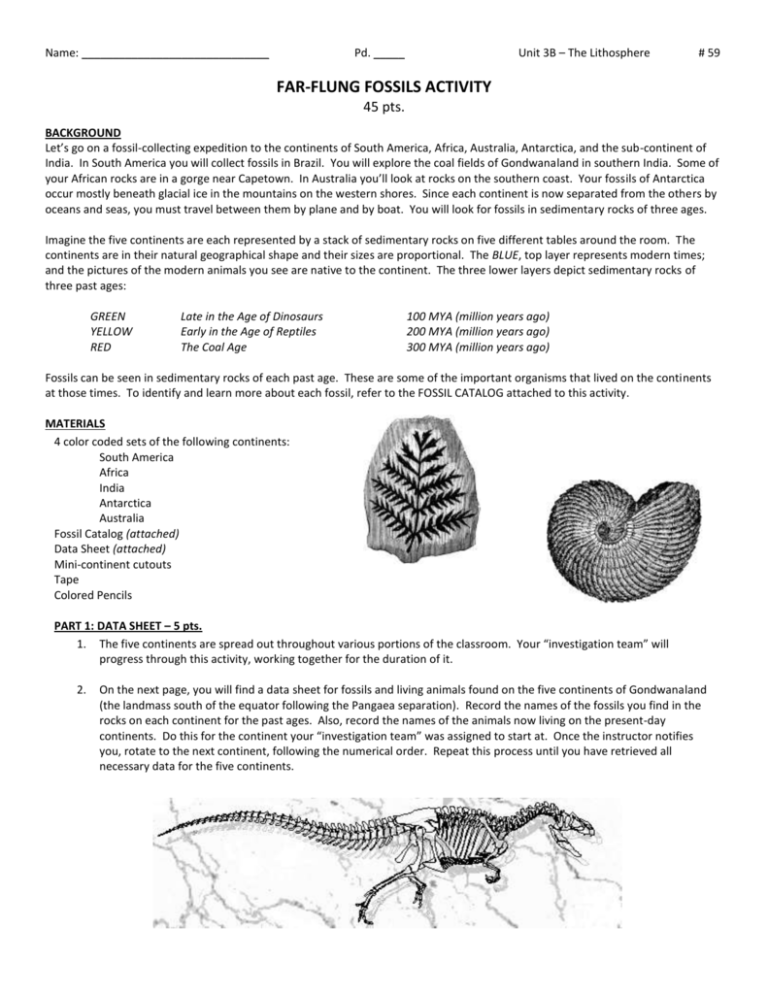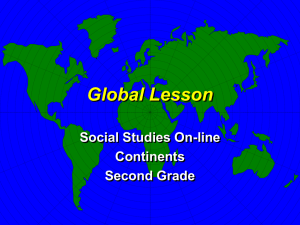Far-Flung Fossils Activity (#59)
advertisement

Name: ______________________________ Pd. _____ Unit 3B – The Lithosphere # 59 FAR-FLUNG FOSSILS ACTIVITY 45 pts. BACKGROUND Let’s go on a fossil-collecting expedition to the continents of South America, Africa, Australia, Antarctica, and the sub-continent of India. In South America you will collect fossils in Brazil. You will explore the coal fields of Gondwanaland in southern India. Some of your African rocks are in a gorge near Capetown. In Australia you’ll look at rocks on the southern coast. Your fossils of Antarctica occur mostly beneath glacial ice in the mountains on the western shores. Since each continent is now separated from the others by oceans and seas, you must travel between them by plane and by boat. You will look for fossils in sedimentary rocks of three ages. Imagine the five continents are each represented by a stack of sedimentary rocks on five different tables around the room. The continents are in their natural geographical shape and their sizes are proportional. The BLUE, top layer represents modern times; and the pictures of the modern animals you see are native to the continent. The three lower layers depict sedimentary rocks of three past ages: GREEN YELLOW RED Late in the Age of Dinosaurs Early in the Age of Reptiles The Coal Age 100 MYA (million years ago) 200 MYA (million years ago) 300 MYA (million years ago) Fossils can be seen in sedimentary rocks of each past age. These are some of the important organisms that lived on the continents at those times. To identify and learn more about each fossil, refer to the FOSSIL CATALOG attached to this activity. MATERIALS 4 color coded sets of the following continents: South America Africa India Antarctica Australia Fossil Catalog (attached) Data Sheet (attached) Mini-continent cutouts Tape Colored Pencils PART 1: DATA SHEET – 5 pts. 1. The five continents are spread out throughout various portions of the classroom. Your “investigation team” will progress through this activity, working together for the duration of it. 2. On the next page, you will find a data sheet for fossils and living animals found on the five continents of Gondwanaland (the landmass south of the equator following the Pangaea separation). Record the names of the fossils you find in the rocks on each continent for the past ages. Also, record the names of the animals now living on the present-day continents. Do this for the continent your “investigation team” was assigned to start at. Once the instructor notifies you, rotate to the next continent, following the numerical order. Repeat this process until you have retrieved all necessary data for the five continents. PART 2: MINI-CONTINENT ARRANGEMENT – 20 pts. 1. Cut out the mini-continents. These represent five continents in the southern hemisphere today. Label your cutouts and use the scheme described to color your continents accordingly: South America: GREEN, Africa: YELLOW, Antarctica: BLUE, India: ORANGE, Australia: PURPLE. Now, arrange them below, using tape, according to where you think they were situated during each of the three past ages, along with how they appear in present time. ANALYSIS QUESTIONS – 20 pts. 1. On the basis of what you found in the RED rocks, 2. 3. 4. 5. a. Which continents had similar fossils? ___________________________________________________________________________________ b. From the fossil evidence, which continents seem to have been connected 300 MYA? ___________________________________________________________________________________ On the basis of what you found in the YELLOW rocks, a. Which continents had similar fossils? ___________________________________________________________________________________ b. From the fossil evidence, what can you tell about the connections of the continents 200 MYA? ___________________________________________________________________________________ On the basis of what you found in the GREEN rocks, a. Which continents had similar fossils? ___________________________________________________________________________________ b. From the fossil evidence, which continents seem to have been connected 100 MYA? ___________________________________________________________________________________ In part 2 of this activity, where you arranged the mini-continent cutouts, explain your reasons for putting the continents together as you did for each of the following time periods: a. 300 MYA ___________________________________________________________________________________ ___________________________________________________________________________________ b. 200 MYA ___________________________________________________________________________________ ___________________________________________________________________________________ c. 100 MYA ___________________________________________________________________________________ ___________________________________________________________________________________ Look at the black arrows on the red rocks of the continents. The arrows represent grooves in the rock. The grooves were carved by advancing continental glaciers about 300 MYA. The arrows point in the direction of glacial movement. a. Suppose you were the first person to have found the glacial grooves in SE South America. From where would it seem the glacier came? ___________________________________________________________________________________ Could the glacier have come from the ocean? Explain your answer. ___________________________________________________________________________________ ___________________________________________________________________________________ ___________________________________________________________________________________ b. Why would the geologist who first found the glacial grooves in India be puzzled by the discovery? ___________________________________________________________________________________ c. How might the idea of continental drift explain 300 million-year-old glacial grooves on four separate southern continents? ___________________________________________________________________________________ d. Make an “X” on the map on the previous page to indicate the spreading center of the glaciers. Where on the surface of the Earth was the probable location of the “X” 300 MYA? (North Pole or South Pole – Remember that a continental glacier tends to move out and away from its center like a spreading mass of bread dough). ___________________________________________________________________________________ e. Where would you look for glacial grooves in the 300 million year old rock of Antarctica? Draw arrows where you would expect to find glacial grooves in Antarctica on the map on the previous page. ___________________________________________________________________________________ 6. Two species of living earthworms in the soils of southern South America and Africa were found to be very closely related (members of the same genus). Also, two species of living earthworms in soils of southern India and southern Australia were found to be very closely related (members of the same genus). How was the theory of continental drift strengthened by discoveries of closely related earthworms on widely separated continents? ___________________________________________________________________________________ ___________________________________________________________________________________ ___________________________________________________________________________________ 7. Examine the mammal’s pictures on the continents of South America, Africa, India, and Australia. These living animals are native on their continents. Each eats insects, and is a major ant/termite eater among all the mammals there. Each species belongs to a different order of mammals. These four mammals are very distantly related, even though each is highly specialized for eating ants and/or termites. Explain in terms of continental drift how four very different kinds of ant/termite eaters could occur in India, Africa, South America, and Australia. ___________________________________________________________________________________ ___________________________________________________________________________________ ___________________________________________________________________________________










